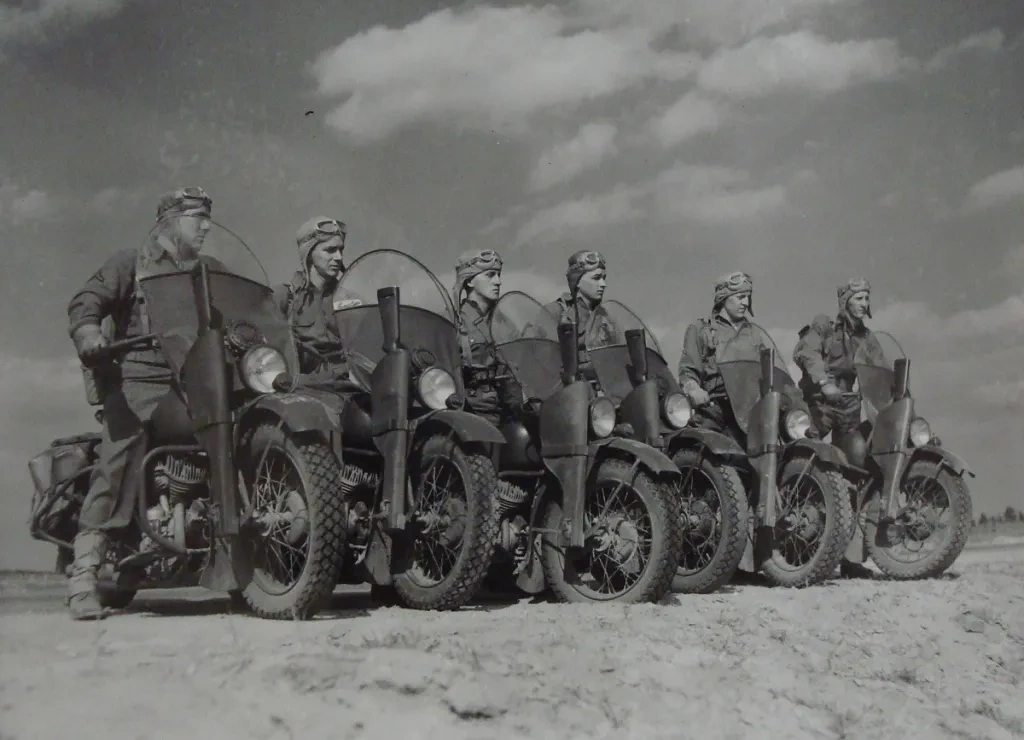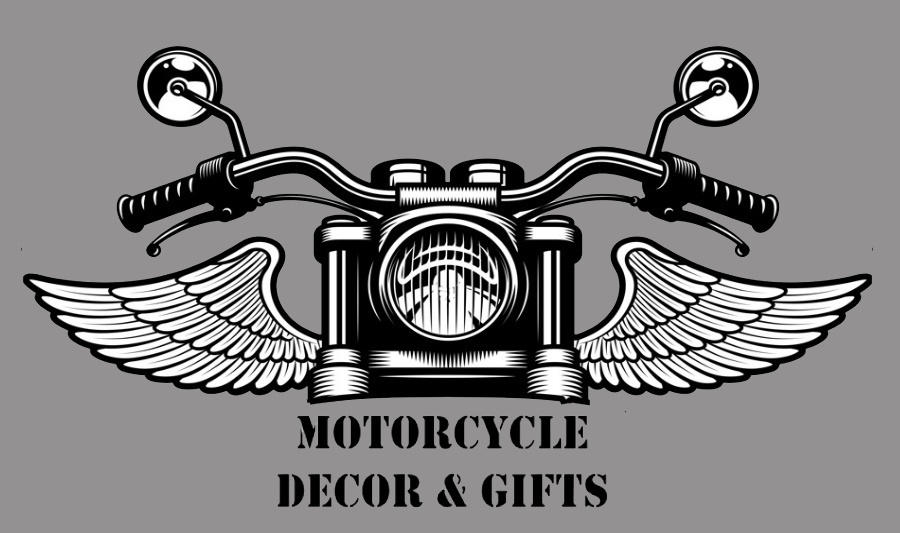
The Road to Victory: Harley-Davidson in World War II
Beyond the iconic image, Harley-Davidson played a crucial role in the Allied victory, supplying a staggering 88,000 motorcycles to the United States and its allies. But their contribution wasn’t just about numbers; it was about versatility, reliability, and a spirit of freedom that roared along with every engine.
From Civilian Cruiser to Military Workhorse:
The motorcycle that became the workhorse of war was the WLA. Based on the civilian 45 Model, the WLA was stripped down for ruggedness and ease of maintenance. Gone were the chrome accents and fancy paint jobs, replaced by olive drab paint, blackout lights, and a focus on pure functionality.
The WLA wasn’t the fastest or most powerful bike on the road, but it was tough, dependable, and could navigate even the roughest terrain. Its simple design made it easy to repair in the field, a crucial factor when spare parts were scarce.
Beyond the Front Lines:
While many imagine motorcycles charging into battle with guns blazing, the WLA’s primary role was behind the scenes. These motorcycles were the communication lifeline of the Allied forces, carrying messages, orders, and vital supplies between units. They served as reconnaissance scouts, weaving through enemy lines to gather intelligence and relay troop movements.
The WLA also played a vital role in military police duties, patrolling camps and enforcing discipline. And, perhaps most importantly, they provided a much-needed boost of morale for soldiers, symbolizing freedom and mobility in the midst of a brutal conflict.
A Global Effort:
Harley-Davidson wasn’t the only motorcycle manufacturer contributing to the war effort, but they were the clear leader. Their production lines churned out WLAs not just for the US Army, but also for allies like Great Britain, Canada, and even the Soviet Union.
The WLA became a symbol of Allied cooperation, traversing continents and battlefields to help secure victory.
The Enduring Legacy:
After the war, the WLA’s legend lived on. Many were sold as surplus, becoming affordable rides for returning veterans and young civilians alike. The WLA’s ruggedness and simple design made it a popular choice for decades, further cementing Harley-Davidson’s association with freedom and adventure.
Today, the WLA remains a cherished piece of history, a testament to American ingenuity and the vital role Harley-Davidson played in World War II. It’s a reminder that sometimes, the roar of a motorcycle engine can be the sound of freedom rolling towards victory.
From Civilian Cruiser to Battlefield Beast the Evolution in WWII
The rugged rumble of a Harley-Davidson WLA motorcycle became synonymous with Allied mobility and resilience during World War II. But few remember the remarkable transformation this beloved bike underwent, morphing from a civilian cruiser into a battle-ready workhorse. Today, we dive into the engine oil and grease to explore the technical evolution of the WLA and how Harley-Davidson adapted it to conquer the toughest terrains and unforgiving conditions of war.
From Chrome to Olive Drab:
The civilian 45 Model served as the foundation for the WLA, but gone were the shiny chrome accents and luxurious paint jobs. In their place came a utilitarian makeover:
Olive Drab paint: This uniform color offered camouflage and reduced visibility to enemy eyes.
Blackout lights: No more illuminating targets, only dim lights for essential nighttime navigation.
Simplified fenders: Shorter and sturdier, less prone to getting caught on debris or mud.
Sturdier frame: Reinforced to handle the harsh realities of wartime roads and off-road adventures.
These changes prioritized function over form, transforming the WLA into a lean, mean, fighting machine.
Adapting for the Rough Road Ahead:
Battlefield demands pushed Harley-Davidson’s engineers to innovate. Some key improvements included:
Air cleaner: A revised and sealed air cleaner protected the engine from dust and debris kicked up in the heat of battle.
Water-wading breather: This ingenious contraption allowed the WLA to ford rivers and streams without water damaging the engine.
Saddlebags and racks: These provided essential storage for tools, spare parts, and messages, vital for self-sufficiency on the battlefield.
Luggage carriers: Mounting points for weapons cases and communication equipment broadened the WLA’s utility.
Each modification demonstrated Harley-Davidson’s understanding of the challenges soldiers faced and their commitment to providing reliable transportation in any environment.
Beyond the Engine: From Two Wheels to Teamwork:
The WLA’s evolution wasn’t just about hardware. Harley-Davidson recognized the importance of training and maintenance:
Military manuals: Detailed instructions for operation and repair ensured soldiers could keep their WLA running, even in remote locations.
Spare parts kits: Standardized parts and readily available replacements minimized downtime and kept the flow of information and supplies moving.
Mechanic training: The company trained both military personnel and civilian mechanics to service and maintain the WLA, creating a robust support network.
By nurturing a culture of knowledge and resourcefulness, Harley-Davidson ensured the WLA remained a dependable partner throughout the war.
The Legacy of Evolution:
The WLA’s wartime adaptations didn’t end with the final battle. Many of these improvements found their way back into civilian models, shaping Harley-Davidson motorcycles for generations to come. The sturdier frames, weatherproof features, and focus on practical functionality became hallmarks of the brand, a testament to the lessons learned on the battlefield.
The WLA’s story isn’t just one of mechanical advancements; it’s a testament to human ingenuity, adaptability, and unwavering determination. It’s a reminder that even the most iconic machines can transform to meet the demands of the moment, and in doing so, leave an enduring legacy of innovation and resilience.
So, the next time you hear the unmistakable rumble of a Harley-Davidson, remember its wartime ancestor, the WLA. This motorcycle didn’t just conquer battlefields; it conquered challenges, evolved to overcome adversity, and left a lasting mark on the world, one revolution at a time.
Battlefield to Street: The WLA Shaped Motorcycle Culture
The rumble of a Harley-Davidson roars more than just an engine; it echoes through history, carrying the stories of war heroes, adventurers, and rebels. At the heart of this legend lies the WLA, the unassuming motorcycle that transformed from civilian cruiser to wartime workhorse and, in the process, reshaped motorcycle culture and American identity.
From Chrome to Camouflage:
Born from the civilian 45 Model, the WLA traded its shiny chrome for olive drab paint, stripping away ostentatiousness and embracing practicality. This wasn’t just a cosmetic change; it symbolized a shift in purpose. The WLA became a tool, a vital cog in the Allied war machine.
Beyond the Battlefield: A Symbol of Freedom
While its image is often tied to battlefields, the WLA’s impact extended far beyond. It became a symbol of freedom and individual spirit, both for soldiers yearning for a taste of normalcy amidst the chaos of war and for civilians back home, representing the adventurous spirit that defined America.
Shaping a Culture on Two Wheels:
The WLA’s influence on motorcycle culture is undeniable. Its ruggedness and adaptability inspired generations of riders to explore unpaved roads and embrace the open highway. Its image permeated popular culture, from Marlon Brando’s rebellious portrayal in “The Wild One” to countless biker films and music videos.
More Than Just Metal and Rubber:
The WLA’s legacy transcends its mechanical form. It embodies the American spirit of resilience, resourcefulness, and a thirst for freedom. It’s a reminder that even the most challenging times can give rise to innovation and cultural shifts.
A Legacy that Endures:
Today, the WLA remains a cherished piece of history, adorning museum floors and vintage motorcycle rallies. Its rumble is a nostalgic nod to a bygone era, yet its spirit continues to inspire riders and dreamers, reminding us that the open road awaits, beckoning us to embrace the adventure just like the soldiers who first rode the WLA into the unknown.
So, the next time you hear that unmistakable Harley rumble, remember that it’s more than just the sound of an engine. It’s the echo of a legacy, a testament to the transformative power of a motorcycle that went from civilian cruiser to battlefield hero, forever shaping the way we see motorcycles and ourselves.
